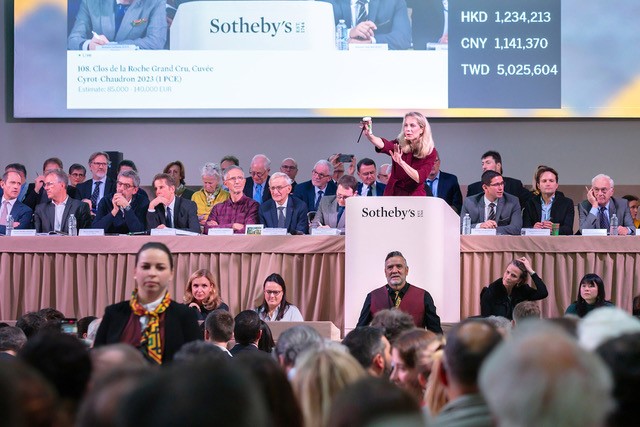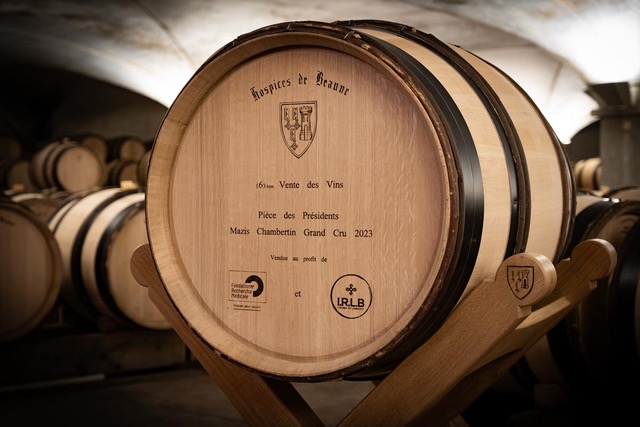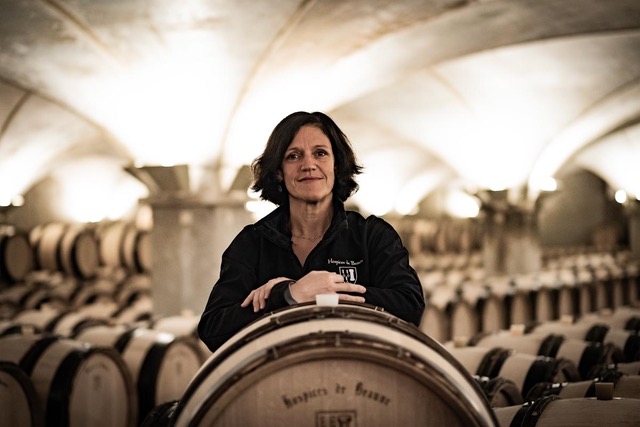In recent memory, prices for Burgundy have seemed to defy gravity—they always rise. The prices at this year’s recently completed Hospices de Beaune auction, the 163rd, actually fell, demonstrating that gravity does exist there. The average price per barrel was €30,839 ($33,642), down 14 percent compared to 2022, but consumers may not notice any difference anytime soon because of the complexity of the market. Still, it’s good news because the 2023 vintage was even larger than the generous and superb 2022, so cellars are full, which at least sets the stage for possible price reductions. That said, the priciest barrel, a grand cru, Bâtard-Montrachet Cuvée Dames de Flandres, went for €350,000 ($381,500), up 14 percent compared to last year.

The Hospices de Beaune auction is no ordinary wine auction. This auction catalogue lists no special bottles, no extravagant vacations, no winemakers’ dinners. The locals call it Vente des Vins (sale of wines) because that what’s sold: barely finished-fermenting, unfinished wine still in barrel from the just completed harvest. Until 2005, bidding was limited to local négociants, such as Albert Bichot, Louis Jadot, or Robert Drouhin, to name just three, who would perform the élevage (literally, raising or finishing) the wine, bottle, and sell it via the usual commercial channels roughly two years after the auction. Now, however, Sotheby’s runs the auction and individuals can bid—in person, via the internet, or via telephone. Winning bidders take delivery of the wine in barrel, called une piece in Burgundy, which contains 228 liters or about 300 bottles. An individual whose bid is successful will have arranged, in advance, with a local négociant to raise, bottle, and ship the wine. At least one négociant, Albert Bichot, allows individuals to buy one-quarter or one-half a barrel by putting customers together. (https://hospices-beaune.com/en/buy-wine-auction/faq-how-to-buy-barrel-hospices-beaune-auction-albert-bichot/).
In addition to obtaining a top-notch Burgundy, an additional incentive for individuals to bid is to see their name on the label. The label of the bottled wine contains the emblem of the Hospices de Beaune, the appellation and name of the cuvée, the négociant who raised the wine, and the name of the individual who purchased it.
The Ventes de Vins weekend, highlighted by the auction on the third Sunday in November, is, in a word, a blast, both for wine geeks as well as people who just like to party. Wine enthusiasts will arrive a week or two in advance and arrange tastings. Then, on Friday night, the charming town of Beaune (population 20,000) hosts an enormous outdoor party. Lights, street performers, marching bands, and an influx of 40,000 merry makers transform the normally sleepy town. Locals will greet you with, “bon Ventes de Vins,” much as we would say, “good afternoon.” Pop-up food stands offering foie gras, frogs’ legs, oysters, and oeufs en murette, the uniquely Burgundian dish of eggs and bacon poached in red wine or sauced with Époisses, surround the Place Carnot and adjacent streets. Wine, of course, flows everywhere. It’s a family affair with parents pushing kids in strollers and dogs hoping for—and usually finding—dropped morsels. At times the streets are so densely packed, it’s difficult to move. Saturday features a cork-pulling contest as well as the traditional half-marathon through the vineyards that starts, oddly enough, at two in the afternoon, “to give runners time to have a decent lunch,” as one resident explained to me. This year multiple art exhibits in Beaune and Pommard featuring local artists drew crowds.
The origin of the wines is as unique as the auction itself. The Hospices de Beaune (hospital of Beaune) owns about 150-acres of vineyards, most of which are classified as grand or premier cru, that have been donated to it over the centuries, making it one of the largest landowners and one of the most important producers in Burgundy. So, along with a Chief of Medicine and Chief of Surgery, the hospital has a full-time winemaker, who supervises 20-plus winegrowers that tend the vineyards. (As a physician myself, I’d love to attend those staff meetings!)
At this year’s auction, the 754 barrels sold raised about €23.3 million ($25.4 million). A special barrel, Pièce des Présidents, which contained a Grand Cru, Mazis-Chambertin, Cuvée Madeleine Collignon, fetched €350,000 ($381,500), which will be donated to two charities, Fondation pour la Recherche Médicale (FRM) and the Initiative de Recherche pour une Longévité en Bonne Santé (IRLB), both of which are dedicated to research into improving life expectancy and maintaining good health. The remaining roughly €23 million goes to the Hospices de Beaune to finance major new structural projects in 2024, including construction of a new hospital building, upgrading hospital equipment with cutting edge technology, and modernizing the winery.

The barrel itself for the Pièce des Présidents came from a 200-plus year-old oak tree, the majority of which was used as the new spire in the rebuilding of Notre Dame de Paris that was destroyed in 2019. Enough remained after the spire was in place to be used to make the special barrel.
Although most of the buyers hailed from Europe—Albert Bichot alone purchased 156 barrels, accounting for fully one-third of the sales—the sale attracted buyers from all over Asia, including Hong Kong, Japan, Taiwan, Singapore, and China, according to Matthew Floris, press officer for Sotheby’s.

Ludivine Griveau, the current winemaker and first female to hold that position, was very pleased with the quality of the 2023s. From Hospices de Beaune vineyards, she produced 51 cuvées (bottlings) in 2023. She explained that variable weather during the growing season resulted in uneven ripening of the grapes. So, she and her team had to make a severe selection to eliminate diseased, unripe, or over-ripe ones. She estimated that she discarded 10 to 15 percent of the crop that made it to the winery and added that the harvesters could have discarded twice that amount in the vineyard. As a result, fewer barrels were up for sale at the 2023 auction (754 barrels, 475 of red and 179 or white) compared to 802 in 2022, despite a larger harvest.
To me, though the reds of 2023 were more difficult to taste because of their structure compared to the suave 2022s, they had purity of fruit, enlivening acidity, and balance. It appears Griveau’s severe selection paid off. If other producers did as well—and it’s far too early to tell—the 2023 vintage could be notable for both quantity and quality.
For details concerning the 2024 Hospices de Beaune auction, always held on the third Sunday in November, contact Sotheby’s by emailing [email protected] or [email protected].
